Abstract
1 The plasma levels of disopyramide and mono-N-dealkyldisopyramide were measured from 118 patients, and the protein binding of both drugs from 50 patients during chronic oral disopyramide therapy. 2 No significant correlation was seen between the daily dose of disopyramide and the achieved plasma drug concentration. 3 The concentration of mono-N-dealkyldisopyramide in the plasma was about one third of that of disopyramide in patients with normal renal function. 4 The mean plasma levels of disopyramide and mono-N-dealkyldisopyramide were high in patients with renal impairment. In patients with simultaneous therapy with enzyme inducing drugs the mean levels of disopyramide were low and those of mono-N-dealkyldisopyramide high. 5 In patients with effective treatment of ventricular arrhythmias the levels of disopyramide were significantly higher than in those with ineffective treatment; the difference was not significant in supraventricular arrhythmias. Patients with side-effects had slightly though not significantly higher disopyramide levels than patients without side-effects; mono-N-dealkyldisopyramide concentrations were identical. 6 The average protein binding of disopyramide was 82%, and that of mono-N-dealkyldisopyramide 22-35%. Although a concentration dependent binding of disopyramide was seen within an individual, the average protein binding did not vary significantly at different concentrations of all samples analyzed. The protein binding was not altered in renal insufficiency, but was slightly decreased by high concentrations of mono-N-dealkyldisopyramide.
Full text
PDF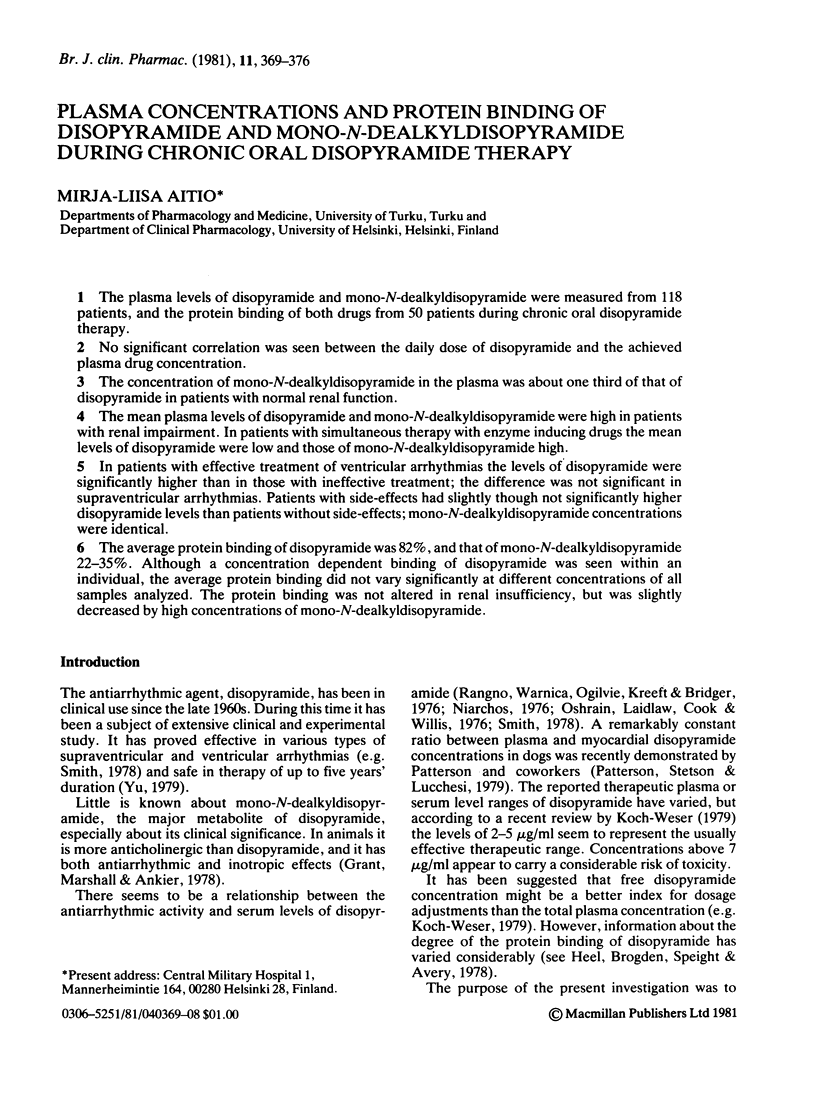
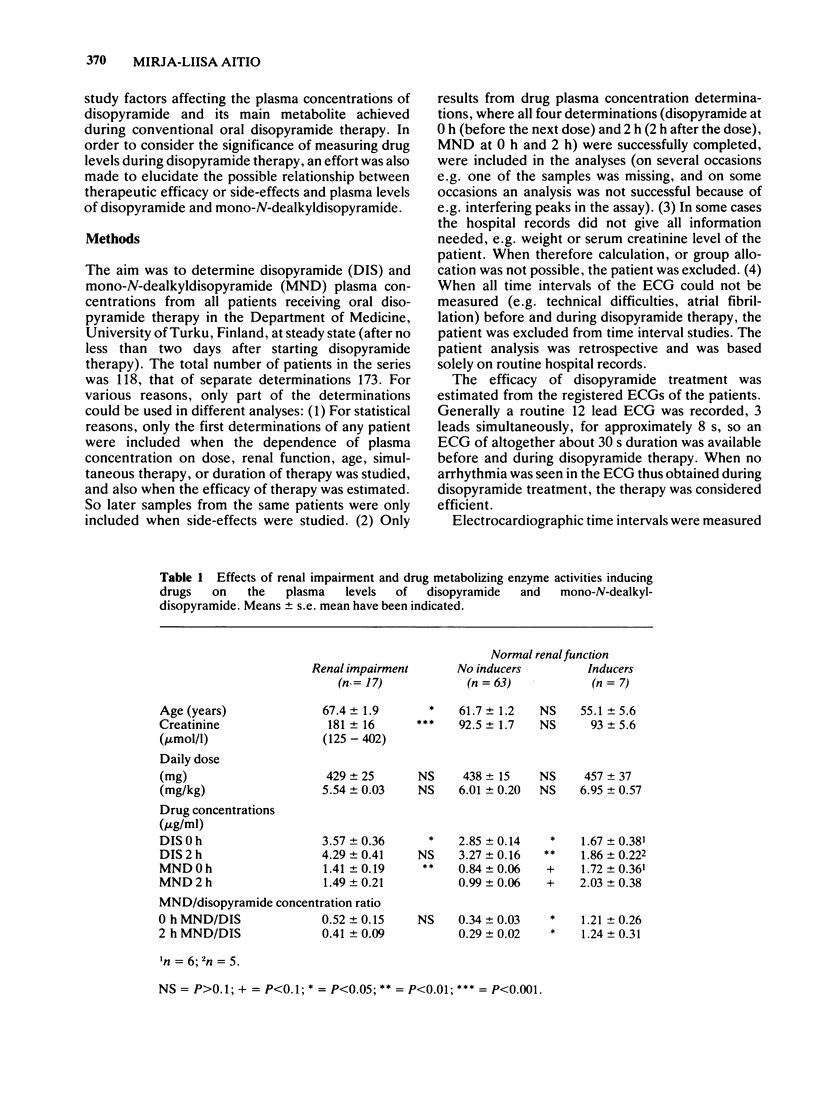
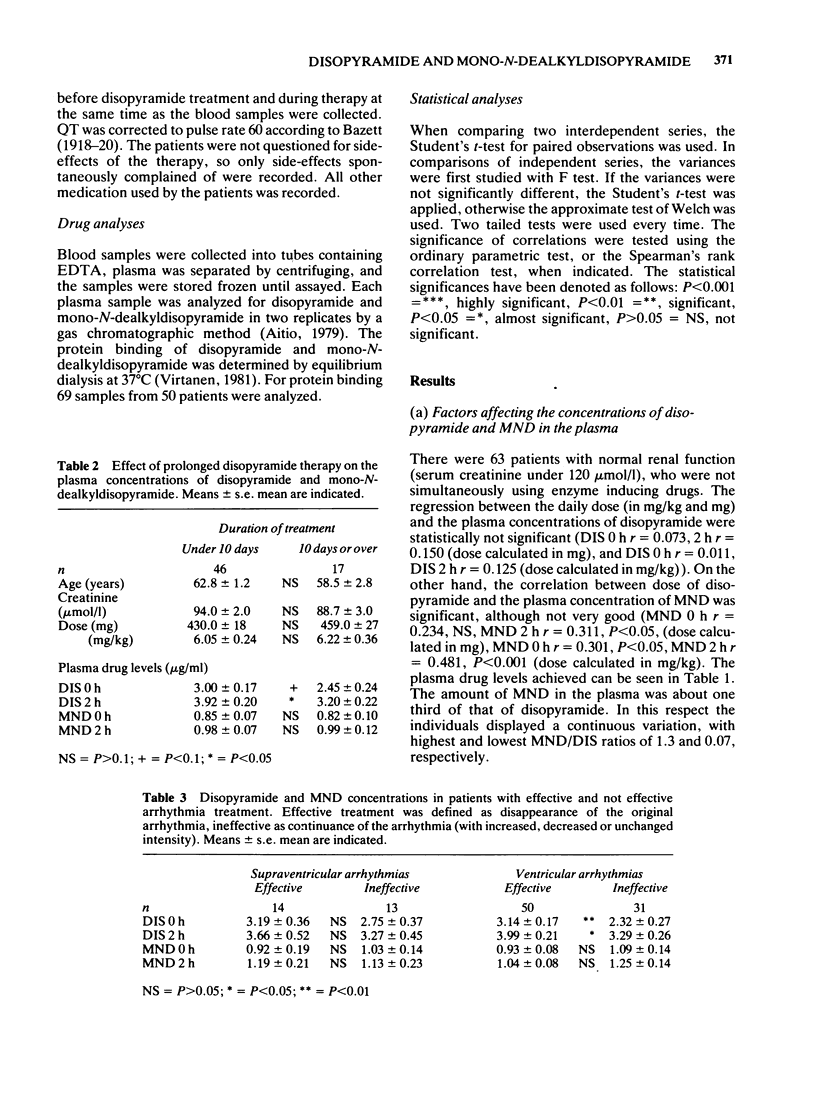
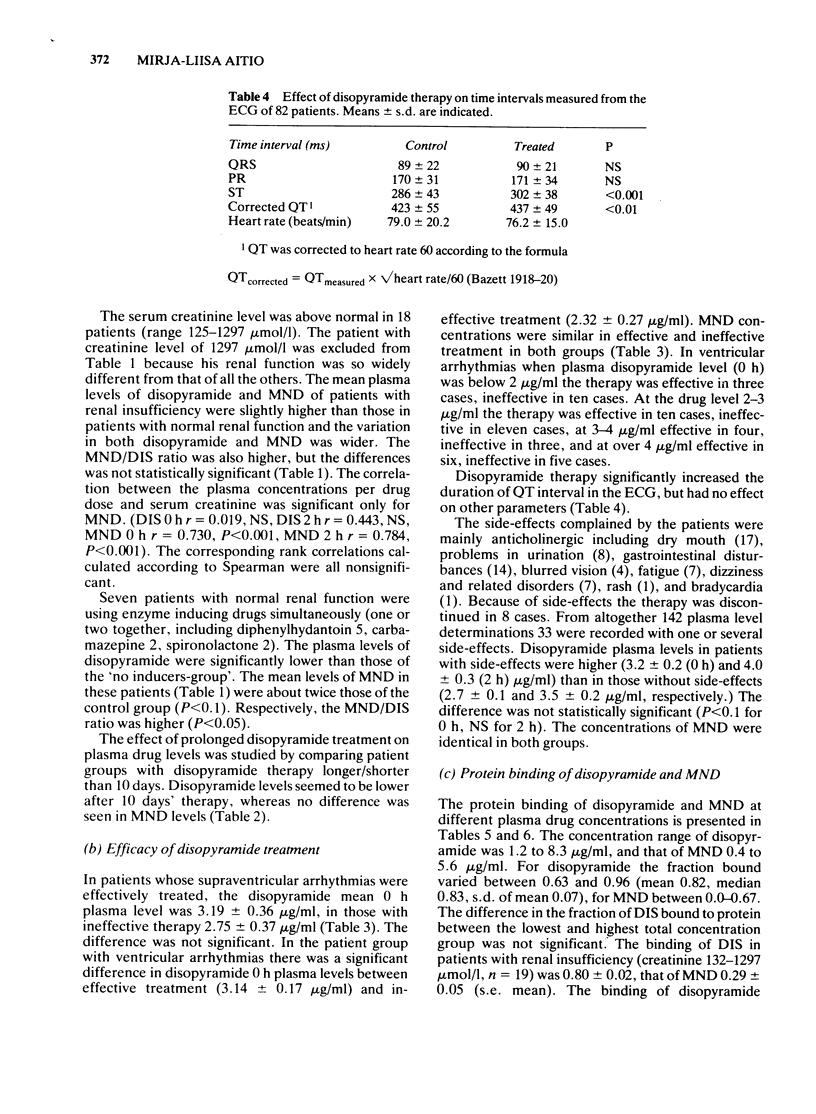
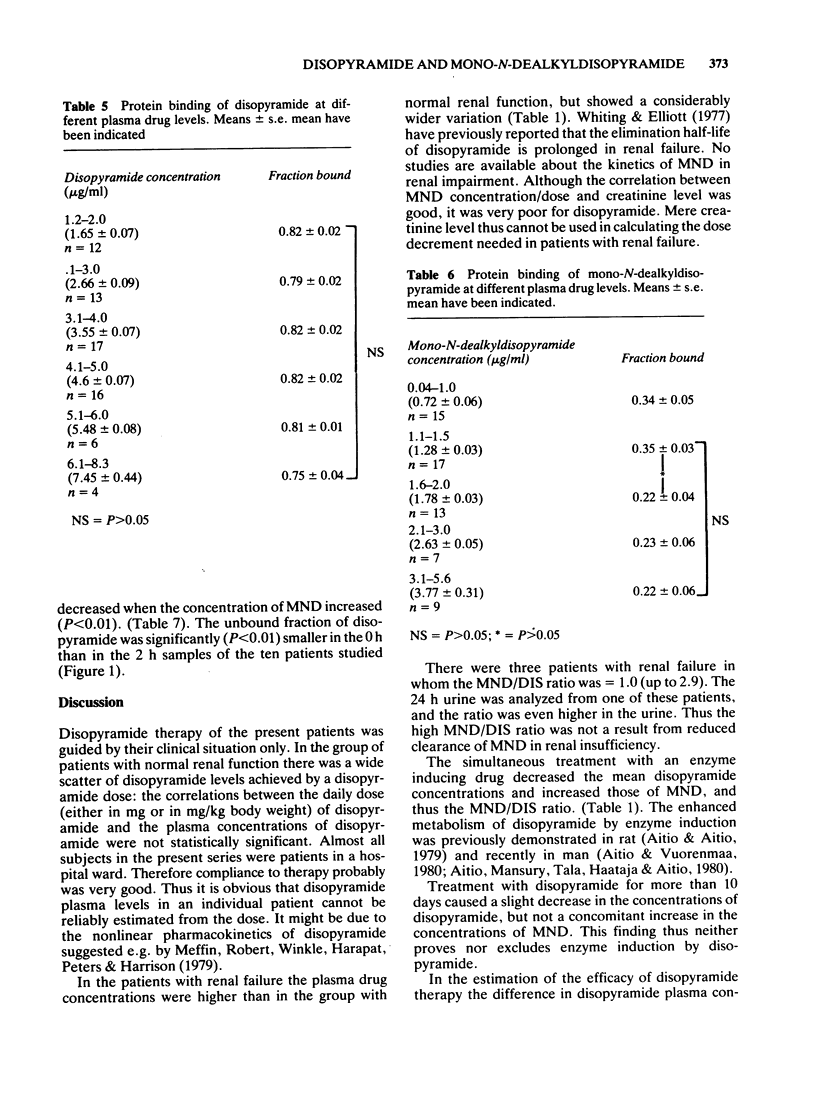
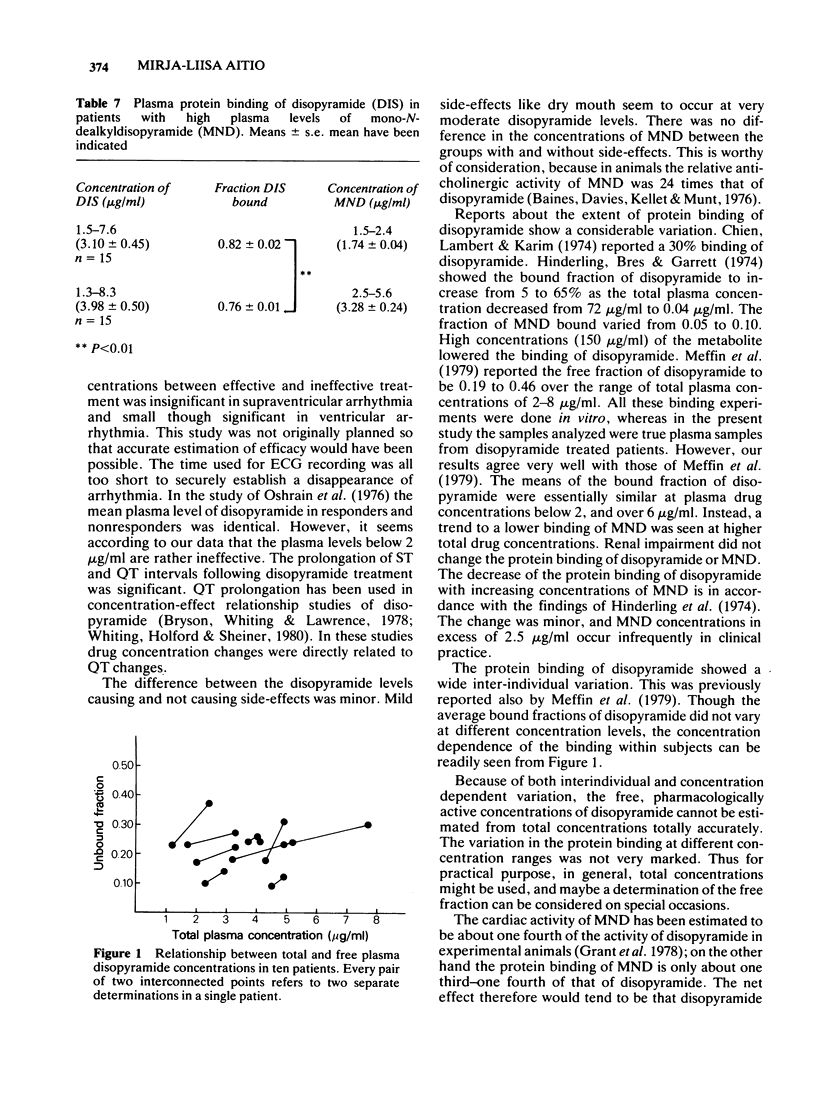
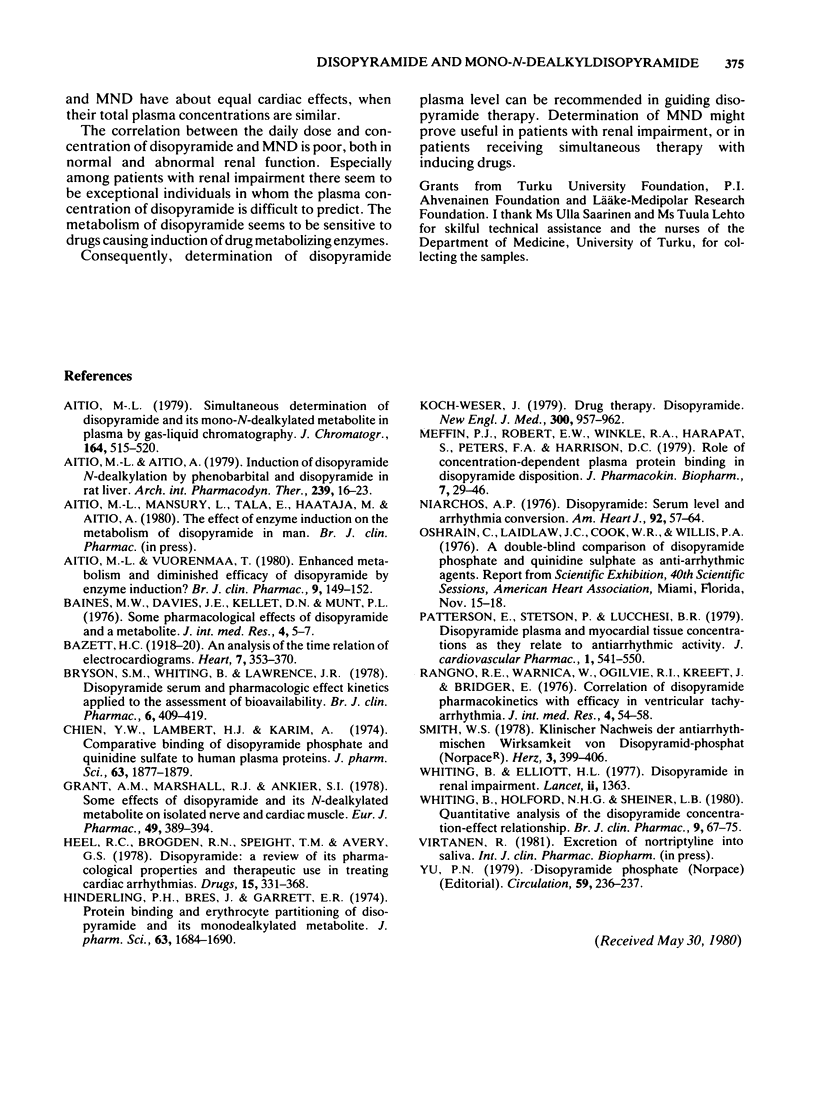
Selected References
These references are in PubMed. This may not be the complete list of references from this article.
- Aitio M. L., Aitio A. Induction of disopyramide N-dealkylation by phenobarbital and disopyramide in rat liver. Arch Int Pharmacodyn Ther. 1979 May;239(1):16–23. [PubMed] [Google Scholar]
- Aitio M. L. Simultaneous determination of disopyramide and its mono-N-dealkylated metabolite in plasma by gas-liquid chromatography. J Chromatogr. 1979 Dec 1;164(4):515–520. doi: 10.1016/s0378-4347(00)81556-x. [DOI] [PubMed] [Google Scholar]
- Aitio M. L., Vuorenmaa T. Enhanced metabolism and diminished efficacy of disopyramide by enzyme induction? Br J Clin Pharmacol. 1980 Feb;9(2):149–152. doi: 10.1111/j.1365-2125.1980.tb05825.x. [DOI] [PMC free article] [PubMed] [Google Scholar]
- Baines M. W., Davies J. E., Kellett D. N., Munt P. L. Some pharmacological effects of disopyramide and a metabolite. J Int Med Res. 1976;4(1 Suppl):5–7. [PubMed] [Google Scholar]
- Bryson S. M., Whiting B., Lawrence J. R. Disopyramide serum and pharmacologic effect kinetics applied to the assessment of bioavailability. Br J Clin Pharmacol. 1978 Nov;6(5):409–419. doi: 10.1111/j.1365-2125.1978.tb04605.x. [DOI] [PMC free article] [PubMed] [Google Scholar]
- Chien Y. W., Lambert H. J., Karim A. Comparative binding of disopyramide phosphate and quinidine sulfate to human plasma proteins. J Pharm Sci. 1974 Dec;63(12):1877–1879. doi: 10.1002/jps.2600631210. [DOI] [PubMed] [Google Scholar]
- Grant A. M., Marshall R. J., Ankier S. I. Some effects of disopyramide and its N-dealkylated metabolite on isolated nerve and cardiac muscle. Eur J Pharmacol. 1978 Jun 15;49(4):389–394. doi: 10.1016/0014-2999(78)90313-8. [DOI] [PubMed] [Google Scholar]
- Heel R. C., Brogden R. N., Speight T. M., Avery G. S. Disopyramide: a review of its pharmacological properties and therapeutic use in treating cardiac arrhythmias. Drugs. 1978 May;15(5):331–368. [PubMed] [Google Scholar]
- Hinderling P. H., Bres J., Garrett E. R. Protein binding and erythrocyte partitioning of disopyramide and its monodealkylated metabolite. J Pharm Sci. 1974 Nov;63(11):1684–1690. doi: 10.1002/jps.2600631103. [DOI] [PubMed] [Google Scholar]
- Koch-Weser J. Disopyramide. N Engl J Med. 1979 Apr 26;300(17):957–962. doi: 10.1056/NEJM197904263001705. [DOI] [PubMed] [Google Scholar]
- Meffin P. J., Robert E. W., Winkle R. A., Harapat S., Peters F. A., Harrison D. C. Role of concentration-dependent plasma protein binding in disopyramide disposition. J Pharmacokinet Biopharm. 1979 Feb;7(1):29–46. doi: 10.1007/BF01059439. [DOI] [PubMed] [Google Scholar]
- Niarchos A. P. Disopyramide: serum level and arrhythmia conversion. Am Heart J. 1976 Jul;92(1):57–64. doi: 10.1016/s0002-8703(76)80403-6. [DOI] [PubMed] [Google Scholar]
- Patterson E., Stetson P., Lucchesi B. R. Disopyramide plasma and myocardial tissue concentrations as they relate to antiarrhythmic activity. J Cardiovasc Pharmacol. 1979 Sep-Oct;1(5):541–550. doi: 10.1097/00005344-197909000-00006. [DOI] [PubMed] [Google Scholar]
- Rangno R. E., Warnica W., Ogilvie R. I., Kreeft J., Bridger E. Correlation of disopyramide pharmacokinetics with efficacy in ventricular tachyarrhythmia. J Int Med Res. 1976;4(1 Suppl):54–58. [PubMed] [Google Scholar]
- Smith W. S. Klinischer Nachweis der antiarrhythmischen Wirksamkeit von Disopyramid-phosphat (Norpace). Herz. 1978 Dec;63(36):399–406. [PubMed] [Google Scholar]
- Whiting B., Elliott H. L. Disopyramide in renal impairment. Lancet. 1977 Dec 24;2(8052-8053):1363–1363. doi: 10.1016/s0140-6736(77)90418-4. [DOI] [PubMed] [Google Scholar]
- Whiting B., Holford N. H., Sheiner L. B. Quantitative analysis of the disopyramide concentration-effect relationship. Br J Clin Pharmacol. 1980 Jan;9(1):67–75. doi: 10.1111/j.1365-2125.1980.tb04799.x. [DOI] [PMC free article] [PubMed] [Google Scholar]
- Yu P. N. Disopyramide phosphate (Norpace): a new antiarrhythmic drug. Circulation. 1979 Feb;59(2):236–237. doi: 10.1161/01.cir.59.2.236. [DOI] [PubMed] [Google Scholar]


